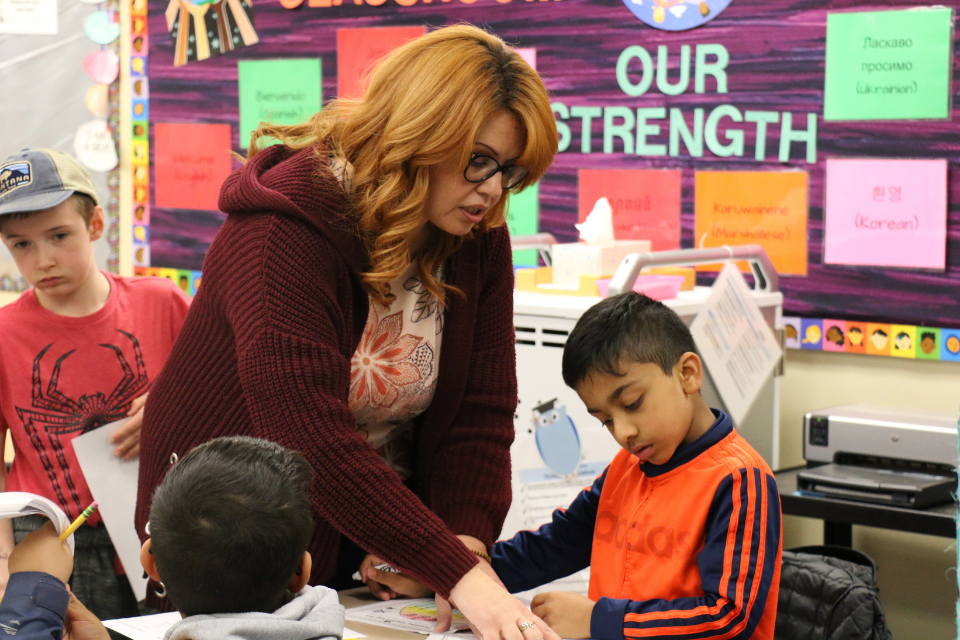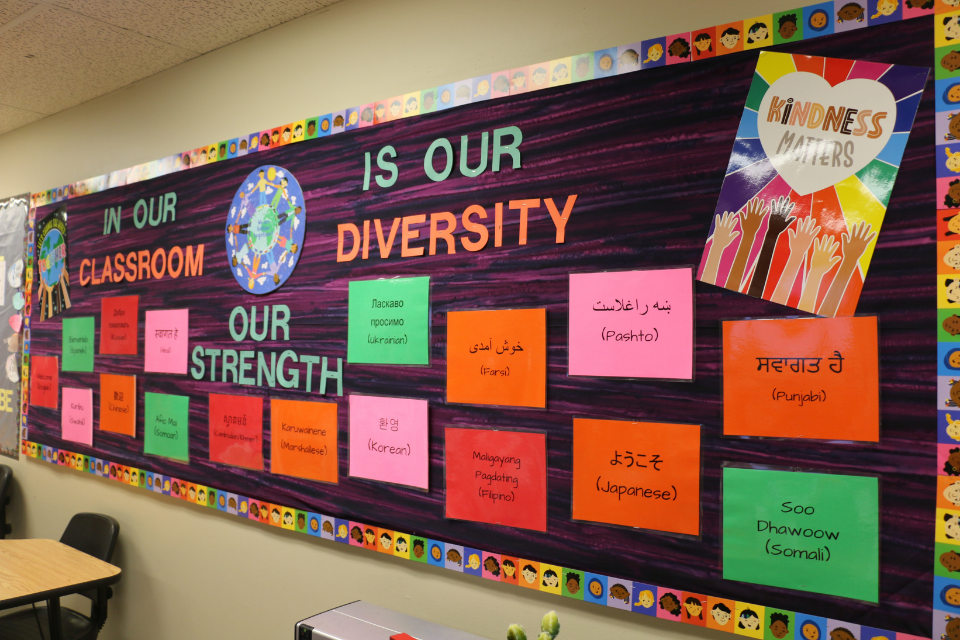Sponsored Content
Auburn schools, WGU work to build a staff that reflects student diversity

Nelda Trujillo in her second grade classroom at Evergreen Heights Elementary in Auburn. “We’ve got to give our kids something to dream about. I want my kids to relate to me. I want them to look at me and dream about being a teacher.” (Photo by Vicki Alonzo, Auburn School District)
Though originally from Texas, Nelda Trujillo, a second-grade teacher at Evergreen Heights Elementary School in Auburn, considers herself homegrown.
Trujillo's relationship with the Auburn School District first began as a parent 15 years ago: Her three kids all graduated from Auburn schools, and she worked as a parent volunteer, helping Spanish-speaking students learn English. A teacher then encouraged her to apply for a paraeducator position. She transitioned into a school-district office job, which she held for six years. She attended Green River College during that period and, after attaining her associate degree, enrolled in the online teachers’ program at WGU Washington.
“I’ve always wanted to be a teacher, but life just threw me curveballs,” she said. “If anything, Auburn School District helped me get back to my dream.”
After 15 years working in the school district, juggling two jobs and three kids during her certification program, all while navigating a pandemic, Trujillo is finally in her first year teaching in-person as a certified full-time teacher. She opted to teach second-graders because of the transitional period in which they find themselves: a “cream of the crop time” between the youth of early elementary school and the greater intensity — as well as standardized testing — that comes in third grade.
Trujillo, like her students, finds herself in a transitioning environment. The Auburn School District, among other Puget Sound communities whose racial, ethnic and cultural makeup have changed in the past 20 years, has identified its paraeducator staff as a talented, local, dedicated and diverse group who, with the right support from their employer and access to quality educational opportunities, can help the school better reflect the diversity of students in their classrooms. Trujillo joins 77 others in the Auburn School District (out of more than 1,000 teachers) who have passed through WGU Washington’s teaching programs to be hired on as teachers.
According to Auburn School District Superintendent Alan Spicciati, 69% of children attending the district’s schools are students of color, while only 17% of staff are people of color.
“It's important for students to see themselves reflected in the adults in the school,” Spicciati said. “And we know students do better if they connect with teachers, especially the teachers, leaders and support staff, who share backgrounds with them.”
The urgency is both moral and pedagogical. Longitudinal research suggests that students with a teacher of color in grades three, four or five saw improved test scores, higher high-school graduation rates, and greater interest in attending college.
“We’ve got to give our kids something to dream about. I want my kids to relate to me,” Trujillo said. “I want them to look at me and dream about being a teacher… If you want to promote educators of color within the community, and you want your community to become the future educators of color, you better have a foundation of educators of color for them to relate to. Because if they can't relate to it, they're not going to shoot for it.”
Auburn has doubled down on a multipronged approach to increase the proportion of staff of color at its schools, and to do so quickly. Central to the school district’s efforts has been the Grow Your Own (GYO) initiative, a Bill & Melinda Gates Foundation-funded project conducted by the Puget Sound Educational Service District (PSESD), a regional authority serving 35 school districts across King, Kitsap, and Pierce Counties.
Launched in 2016, Grow Your Own encourages members of local racially diverse communities to become teachers through alternative teacher certification and improved teacher retention efforts across school districts. Though the Gates Foundation grant sunsetted in Dec. 2021, PSESD is applying for new grant funding to extend and develop regional plans for educator workforce diversification, according to Eileen Yoshina, PSESD’s Director of Equity in Education.
“We have a variety of initiatives related to this goal and the GYO Collaborative that Auburn has been an integral part of will likely evolve into a space that includes collaboration with higher education partners who are also working on diversification efforts,” Yoshina said.
“Auburn is a growing, culturally-diverse community, and many adults over the age of 25 don’t yet have university degrees,” said Dr. Tonya Drake, Chancellor of WGU Washington. “That’s due in part to the distance between the city and the nearest brick-and-mortar universities. Our partnership with Auburn and many other school districts in Washington represents WGU’s commitment to underserved communities and expanding access to education for more people.”
The agreement between Auburn and WGU Washington provides fee waivers, exclusive scholarship opportunities, and student teacher placements within the school district for existing paraeducators. The partnership also provides pathways for district employees to obtain bachelor’s and master’s degrees. Beyond Auburn, WGU Washington focuses its degree programs on traditionally underserved student groups, including rural, low-income, first-generation, and minority students.
“We work closely with school districts and community colleges across the state to develop a pipeline of teachers that represent the communities they serve,” said Constance Dodds, Senior Strategic Partnerships Manager for WGU Washington. “A great example of that work is the Auburn School District.”
Since 2017, the Auburn School District has gone from 19% of its new hires being people of color to, most recently, that figure reaching 60% during the 2021-2022 school year.
But Spicciati, the Superintendent, said some school buildings have yet to reach a critical mass of teachers and staff of color, which can make staff members of color feel isolated or singled out for their race or culture, and hamper the needs of students. The school district looked to peer school districts, namely Highline, to understand how to recruit and retain educators of color from an administrative position. With that in mind, the school district hired Analia Galloway as Director for Recruitment, Retention, and Workforce Development in 2018. It also promoted Isaiah Johnson to Director of Equity, Family Engagement and Outreach in 2019, after 15 years as an assistant principal and principal in the school district.
“We want our staff to feel welcomed, because that's what we want for our students,” Galloway said.
Most recently, Trujillo approached Galloway to create a mentorship program within the school district for and by educators of color. Trujillo said a nurturing experience with her faculty mentor at WGU Washington helped prevent her from “becoming another statistic,” but she also believes that mentorship doesn’t always have to do with purely educational concerns. (The university assigns each of its students a faculty member who guides the students through their courses and all the way to graduation. Trujillo envisions a similar model that helps teachers with more than just classroom challenges.)
“It's not always about the curriculum, the academics, the attendance, the kids’ lives at home. What am I doing for myself as an educator of color to keep my soul fresh? What am I doing for myself to keep my mind ahead of the game? What am I doing for myself to make sure that my shield is not wearing down?” she said.
In the interim, and to foster regional connections, the school district has also directed staff of color to regional affinity groups, such as the Puget Sound Educators of Color Leadership Group.
“We can recruit, recruit, recruit all we want, but if our spaces don't honor and don't bring dignity to our staff of color, we're just going to continue to shuffle staff of color in and out,” Johnson said.
Funding remains a challenge for school districts and aspiring teachers alike. Galloway said that funding is “always an issue,” and that, with greater financial resources, initiatives like Grow Your Own could offer tuition reimbursement or other incentives to mitigate barriers to access. The school district has already bargained for tuition reimbursement, and also lets paraeducators take educational leave for student teaching rather than resign. It works with student teachers to obtain an emergency substitute certificate so that they can sub in their mentor teacher’s classroom, mitigating loss of pay. But Auburn also sees greater possibilities with the right state funding.
Trujillo, for whom teaching was — and is — a dream, thinks greater efforts to make the student teaching process affordable would make the most difference. She thinks “time is of the essence,” as kids can’t grow up more slowly and would benefit from a diverse teaching staff now. Lower barriers to access would let cost-effective online programs accelerate Auburn’s efforts to diversify its teaching staff.
“We've got new faces, new cultures, new traditions that we need to be respectful of, and we need to meet them,” she said. “We need to meet them here.”

Trujillo’s second grade classroom, where 17 different languages are spoken by students. The Auburn School District has increased its number of new staff that are people of color from 19% in 2017 to 60% in 2021. (Photo by Vicki Alonzo, Auburn School District)

